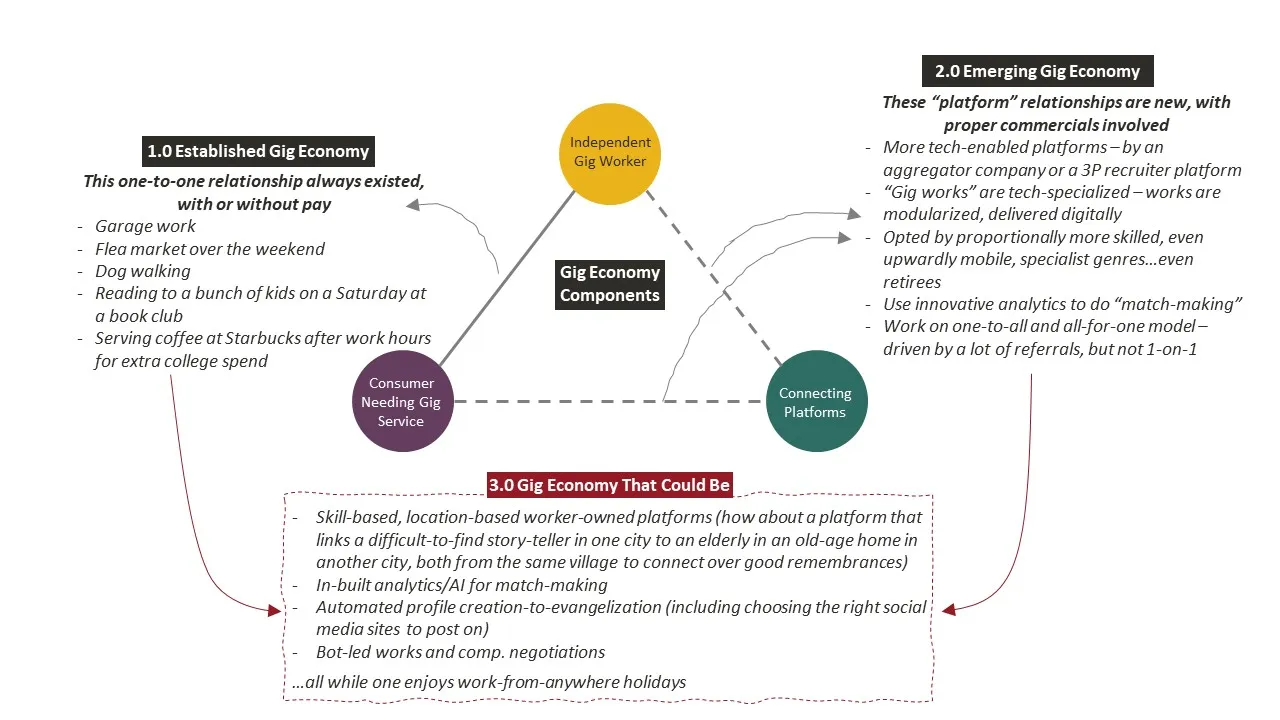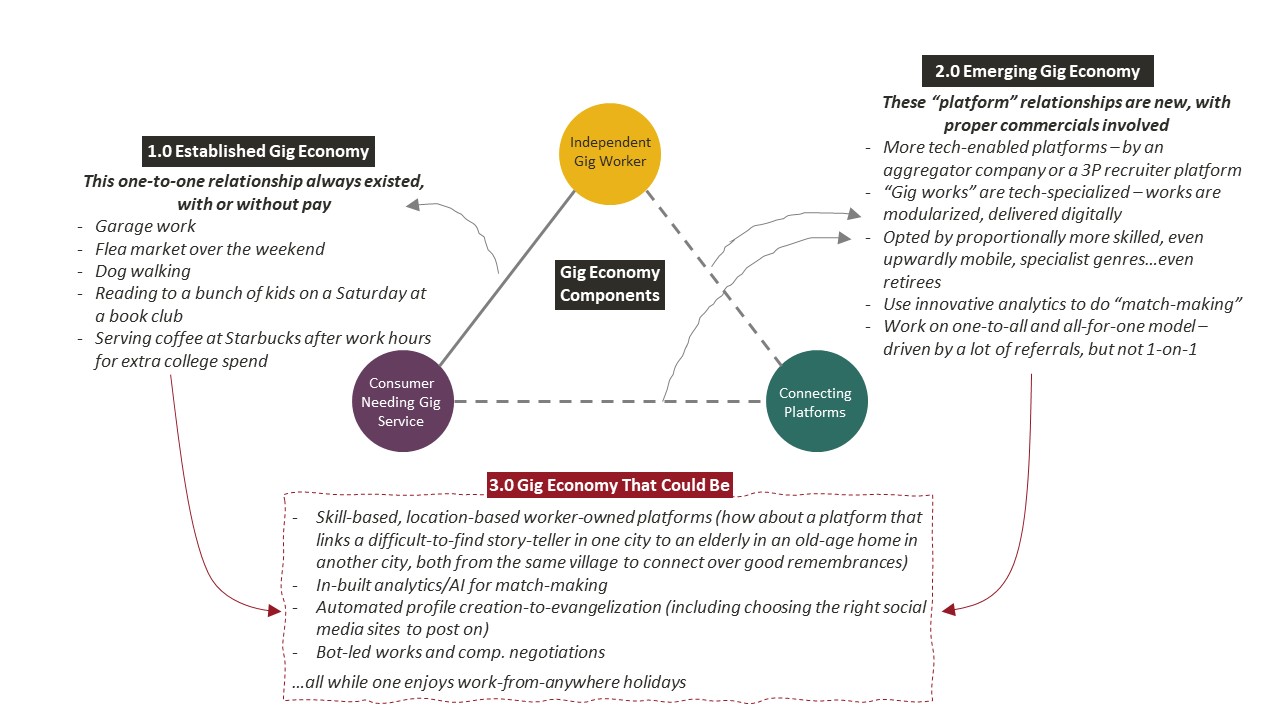Gig work is not informal work. It is skill and choice-based….like having a KitKat!
Blog: NASSCOM Official Blog
The way the world has turned upside down for work, workplaces, and workforce due to COVID-19, KitKat might even start associating the break with Gig. An interesting tagline could be – Have a GIG. Have a Kit-Kat. (This is purely the writer’s creative writing, not a KitKat official branding statement or tagline. The responsibility of this idea lies with the writer solely.)
Gig work is like having a KitKat, wafer by wafer. Each wafer is a gig, looking similar but placed distinctly from the adjoining one. The connective tissue is the chocolate. Carving out each wafer neatly without breaking the chocolate cover is the key to a successful KitKat eater!
In Gig terms, the chocolate tissue could be either the specialist skill that a Gig worker has, which connects multiple different Gigs for the individual and defines her career, or, it could be the organizational work area that ensures that a Gig worker is given connected and meaningfully aligned wafers of work to ensure high engagement.
But the crux of the analogy is that just like one doesn’t stop at one KitKat wafer, Gigs done over and over again, have the potential to become a recognized mainstream work model…and this shift is taking shape, slower in some areas, but definitely a lot faster in Tech-native and digitally-savvy companies.
Why is formalization of “Gig Work” important?
It is, so as to differentiate its current and emerging avatar from the classic definition that makes Gig sound substantially more informal than contract work. So, while in subcontracting, a company may not have any control over the “traditional fixed employees” of the contractor, vis-à-vis a Gig employee who would report into the company still, Gig is still more synonymous to informal than temporary (for that matter, work on H1B visa is also temporary in nature, but much coveted, because it is not informal).
Most dictionaries still define Gig as – “A job, especially one that is informal, temporary, or that has an uncertain future.”
Trends from the US suggest more formalization of the Gig economy that will slowly replace the uncertainty associated with such jobs.
- From 3.6 million in 2016, Gig jobs there could grow to over 9 million by the end of 2021, and maybe even more now due to COVID-19, nearly 3X in 5 years.
- Not just the volume, the nature of Gig jobs suggests a furthermore important shift – gross earnings of people on Gig payrolls increased by an average 21% in 2016, and is likely to hit an all-time high in 2020 actual reportings.
- USA’s National Association of Counties (NACo) started planning through county-level (nearly 3000+), and national-level, labor policy changes to give the Gig work model formal and legal recognition in 2017.
Back home, Tata Consultancy Services (TCS) has initiated a pilot to test alternate work models, including a gig model, to deliver its projects with the same efficacy and seamlessness as in pre-COVID times. TCS calls it the “talent cloud” model and indicates that as long as work can be carved out independently, does it even matter where the expert is. In a no-shores work model, the world is a skilled worker’s job floor!
Infosys estimates that Gig coders would constitute 35% of the Tech industry workforce in the future. Some companies are already enabling their employees to pick short-term Gig projects that the employees can work on without disrupting the core “full-time employment” work, as a way to help build adjacent and vertical skills, and some critically needed experience.
NASSCOM’s latest and first-in-a-series study on Decoding Gig Economy explores how the various Tech industry segments are planning Gig roles across functions and job roles. The report is here for all netizens.
What has been the ongoing Gig model, what’s emerging, and what could a Gig model be?
A Gig model always had two core components – the Gig worker and the Consumer of the Gig service. Anyone who’s attended college with parents not heading to additional pocket-money demands knows how to serve coffee at Starbucks! But these were 1-to-1 roles, word-of-mouth referral based, and very localized. Most of the time, need-based for extra money – not for discretionary spends, but to meet basic needs. It was largely a needy “supplier of skills and capabilities seeking Gig jobs.”
With Ola, Uber, Grab, Airbnb, Amazon, Delhivery, Swiggy, Zomato, etc. the tide has turned. It is now a “consumer led pull of Gig workers”. The impact of this shift has been dramatic on the economy, incomes and lifestyles, and employability of millions of Gig workers.
The state is fluid, and once it settles, the push-pull of the Gig model will become more dynamic, multi-factor driven, established on economic principles, and practically globe-impacting.
How do you see Gig Economy shaping? Let us know your thoughts, views, and ideas. And we will come back with more in this space.
Useful sources:
- NACo Counties Futures Lab – The Future of Work – The Rise of the Gig Economy, 2017
- TCS tries out gig-type working models in pandemic’s wake, Economic Times, November 25, 2020
- White collar Gig workers will be the norm for India Inc., Economic Times, June 26, 2020
- Decoding Gig Economy – Emergent Industry Shift Towards a Blended Work Model, NASSCOM Insights, December 14, 2020
The post Gig work is not informal work. It is skill and choice-based….like having a KitKat! appeared first on NASSCOM Community |The Official Community of Indian IT Industry.

